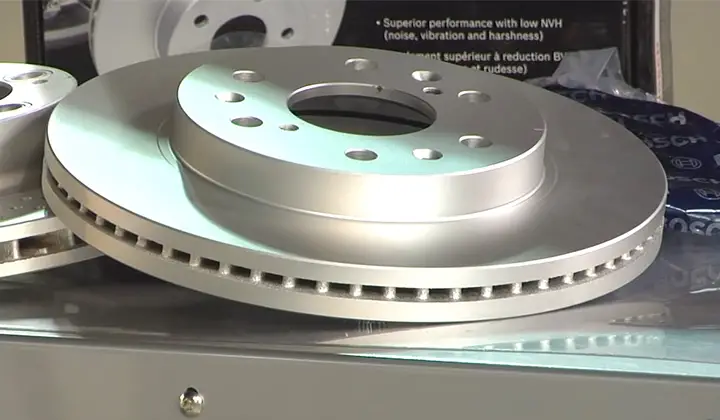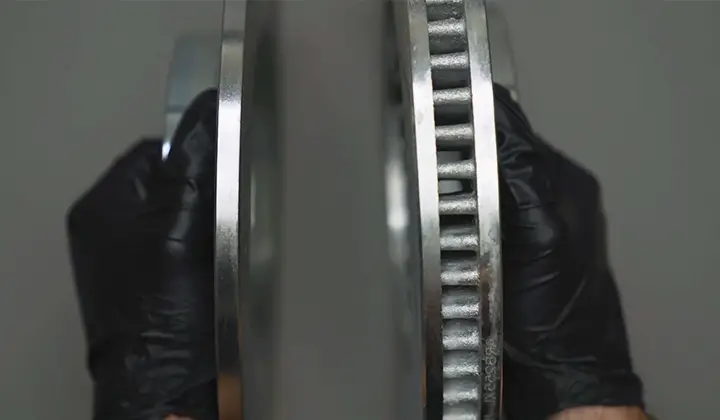A ventilated brake rotor can help to improve your braking system’s performance in adverse weather conditions. By allowing the air to circulate, a vented brake rotor can reduce the amount of dust and dirt that accumulates on the brakes.
Ventilation also allows for better cooling of the brakes during hot weather months, making them more responsive when you need them to be.
If your car has been diagnosed with an “overheating condition”, a vented brake rotor may be necessary in order to prevent any permanent damage done to your engine or transmission
Contents
What Is a Vented Brake Rotor
Ventilated brake rotors are important for your car’s safety and performance. They keep the pads cooler, which prevents them from wearing prematurely and reduces the chance of a failure during braking.
Rotors that have been vented can also help to improve airflow over the rotor, helping to reduce heat build-up on the brake pad surfaces.

You should replace your ventilated brake rotor every five years or 12,000 miles, whichever comes first.
To check if your brakes need a new ventilated rotor, look for an “R” after the VIN number on your driver’s door jamb sticker or near where you attach your parking brake (if it has one).
When replacing a ventilated rotor, always use genuine GM parts because they offer superior cooling and protection compared to knock-off brands
Are Vented Brake Rotors Worth it?
If you’re thinking about getting vented brake rotors, it’s important to weigh the pros and cons first.
Vented brakes work better than traditional brakes when it comes to stopping on a downhill slope or in wet weather, but they can also be more expensive. The decision of whether or not to get vented rotors are up to you.
Rotors are the contact surfaces of the brake system.
The rotor is attached to the hub and is used to contact the brake pads. The rotor has a series of holes in it that let the air escape, which makes it easier for the brake pads to make contact with the rotor.
Decreased Noise and Emissions Levels
Vented rotor systems offer a number of benefits over traditional brake rotors, including decreased noise and emissions levels.
Last Longer
Ventilated rotors also tend to last longer than non-ventilated ones, as they don’t corrode as quickly.
Better Braking Performance
They also provide better braking performance in extreme weather conditions, such as rain or snow.
Easier to Service
Finally, vented brakes are easier to service – you just need to unscrew the bolts and replace the pads instead of removing and rebuilding the entire system like with traditional brakes.
Difference Between Solid and Vented Brake Rotors
Solid brake rotors are made from a single piece of metal that is shaped like a disc. Vented brake rotors have vents cut into them so air can flow through them.

This helps the brakes work more effectively and prevents them from getting too hot.
Solid brake rotors are made of metal and have a solid surface
Vented brake rotors are designed to allow the braking oil to flow through them so that it can dissipate heat.
This is important because it helps prevent your brakes from overheating, which can cause problems with your vehicle’s safety and performance.
Solid brake rotors are heavier than vented ones
This is due to the fact that they contain more metal content, which makes them stronger and harder to wear down over time.
Great stopping power in cold weather
Since colder air has less energy, vented brake rotors will help increase the amount of traction your car has on icy surfaces.
Solid brake rotor discs may need replacement sooner than vented ones
If you live in an area where snow or ice accumulates on the roadway, this could lead to cracks developing in your disc-rotor assembly (the part that sits between the caliper pistons and pads).
When this happens, you’ll likely need to replace both the entire disc-rotor assembly as well as individual components like the mounting brackets or bearings
FAQs
What Is the Purpose of Vented Brake Rotors?
The purpose of vented brake rotors is not only for stopping your car but also for preventing brake failure due to heat build-up and premature wear caused by friction.
How Do You Tell if a Rotor Is Solid or Vented?
There are two types of rotors – solid and vented. The difference is that the solid rotor has a single rotor blade, while the vented rotor has two or more blades.
Do I Need Vented Brake Discs?
If you have a vehicle with a larger engine, then you should get vented brake discs to prevent overheating.
Do Slotted Rotors Wear Pads Faster?
Slotted rotors wear faster than those with pads because they have a tendency to stick to the pads.
Why Are Drilled and Slotted Rotors Better?
Drilled and slotted rotors are a popular choice for many applications because they offer better performance and durability.
Which Way Do Vented Rotors Go?
The answer is, that it depends. There are many factors that come into play when it comes to deciding which way to go with your vents.
There are some rules of thumb that can be helpful in determining what direction you should vent your rotors.
Do Drill Rotors Last Longer?
Drilled rotors are less likely to corrode and last longer than un-drilled ones. They can also be used in more severe conditions. Resurfacing the drilled and slotted rotors will prolong its life too.
Final Words
Vented brake rotors are vented to allow for proper cooling and prevent rusting of the metal plates. Ventilated brake rotor discs reduce the amount of heat your brakes produce, making them last longer and reducing the chance of an accident.
When you replace a ventilated brake rotor, make sure to get one that is compatible with your car’s braking system. If you have questions about whether or not your car needs a vented brake rotor, speak to a mechanic or manufacturer representative.
A properly functioning ventilation system also prevents moisture from building up in the brakes and causing corrosion or rusting over time.
